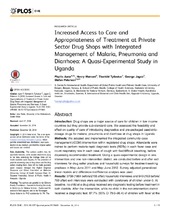| dc.contributor.author | Awor, Phyllis | en_US |
| dc.contributor.author | Wamani, Henry | en_US |
| dc.contributor.author | Tylleskär, Thorkild | en_US |
| dc.contributor.author | Jagoe, George | en_US |
| dc.contributor.author | Peterson, Stefan | en_US |
| dc.date.accessioned | 2015-03-25T14:12:33Z | |
| dc.date.available | 2015-03-25T14:12:33Z | |
| dc.date.issued | 2014-12-26 | eng |
| dc.identifier.issn | 1932-6203 | |
| dc.identifier.uri | https://hdl.handle.net/1956/9659 | |
| dc.description.abstract | Introduction: Drug shops are a major source of care for children in low income countries but they provide sub-standard care. We assessed the feasibility and effect on quality of care of introducing diagnostics and pre-packaged paediatric-dosage drugs for malaria, pneumonia and diarrhoea at drug shops in Uganda. Methods: We adopted and implemented the integrated community case management (iCCM) intervention within registered drug shops. Attendants were trained to perform malaria rapid diagnostic tests (RDTs) in each fever case and count respiratory rate in each case of cough with fast/difficult breathing, before dispensing recommended treatment. Using a quasi-experimental design in one intervention and one non-intervention district, we conducted before and after exit interviews for drug seller practices and household surveys for treatment-seeking practices in May–June 2011 and May–June 2012. Survey adjusted generalized linear models and difference-in-difference analysis was used. Results: 3759 (1604 before/2155 after) household interviews and 943 (163 before/780 after) exit interviews were conducted with caretakers of children under-5. At baseline, no child at a drug shop received any diagnostic testing before treatment in both districts. After the intervention, while no child in the non-intervention district received a diagnostic test, 87.7% (95% CI 79.0–96.4) of children with fever at the intervention district drug shops had a parasitological diagnosis of malaria, prior to treatment. The prevalence ratios of the effect of the intervention on treatment of cough and fast breathing with amoxicillin and diarrhoea with ORS/zinc at the drug shop were 2.8 (2.0–3.9), and 12.8 (4.2–38.6) respectively. From the household survey, the prevalence ratio of the intervention effect on use of RDTs was 3.2 (1.9–5.4); Artemisinin Combination Therapy for malaria was 0.74 (0.65–0.84), and ORS/zinc for diarrhoea was 2.3 (1.2–4.7). Conclusion: iCCM can be utilized to improve access and appropriateness of care for children at drug shops | en_US |
| dc.language.iso | eng | eng |
| dc.publisher | Public Library of Science | eng |
| dc.relation.ispartof | <a href="http://hdl.handle.net/1956/11289" target="blank">Drug shops in integrated community case management of malaria, pneumonia and diarrhoea in Uganda: Appropriateness of care and adherence to treatment guidelines</a> | |
| dc.rights | Attribution CC BY | eng |
| dc.rights.uri | http://creativecommons.org/licenses/by/4.0/ | eng |
| dc.title | Increased access to care and appropriateness of treatment at private sector drug shops with integrated management of malaria, pneumonia and diarrhoea: A quasi-experimental study in Uganda | en_US |
| dc.type | Peer reviewed | |
| dc.type | Journal article | |
| dc.date.updated | 2015-03-03T15:43:38Z | en_US |
| dc.description.version | publishedVersion | en_US |
| dc.rights.holder | Copyright: 2014 Awor et al. This is an open-access article distributed under the terms of the Creative Commons Attribution License, which permits unrestricted use, distribution, and reproduction in any medium, provided the original author and source are credited. | |
| dc.source.articlenumber | e115440 | |
| dc.identifier.doi | https://doi.org/10.1371/journal.pone.0115440 | |
| dc.identifier.cristin | 1219326 | |
| dc.source.journal | PLoS ONE | |
| dc.source.40 | 9 | |
| dc.source.14 | 12 | |
| dc.subject.nsi | VDP::Medical sciences: 700::Health sciences: 800::Community medicine, social medicine: 801 | eng |
| dc.subject.nsi | VDP::Medisinske fag: 700::Helsefag: 800::Samfunnsmedisin, sosialmedisin: 801 | nob |

